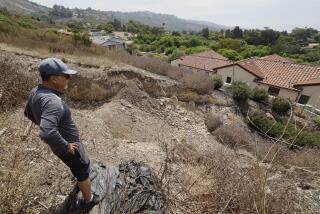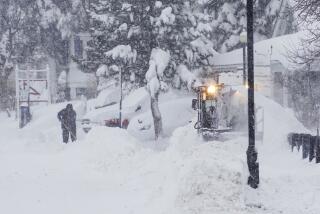Still Without Gas, South Lake Tahoe Starts to Thaw Out
SOUTH LAKE TAHOE, Calif. — Balmy, spring-like weather Monday helped thaw residents who have been without heat or hot water for the last week and led city officials to close their emergency shelter. Meanwhile, utility work crews hoped to begin restoring natural gas service today.
Although the Lake Tahoe Airport and U.S. 50 reopened Monday, city officials cautioned tourists that the area was operating on one-third of its normal electricity because of downed power lines.
“We are not telling people any longer to stay away,” said Joan Phillipe, South Lake Tahoe public information officer. “But anybody who comes up here will have to be as conscientious about conservation as those of us who live up here.”
Most of the 8,000 motel rooms and restaurants surrounding South Lake Tahoe are still closed and without gas-powered heat or cooking ranges, but the major casinos in Stateline, Nev., remain open, operating on auxiliary power.
John Packer, publicist for Harrah’s Lake Tahoe hotel and casino, said that business has dropped substantially since last Thursday when the South Lake Tahoe City Council issued a state of emergency and warned tourists to stay out of town.
“We’re trying to get it so we can start encouraging people to come up as soon as possible,” said Packer, who added that city officials have not decided when they will resume advertisements promoting tourism in the Tahoe Basin. “We’re kind of waiting for the the city’s lead because we don’t want to . . . make enemies in the community.”
Temperatures rose past 50 degrees Monday, causing snow on rooftops to melt in the early morning. The warm weather also aided Southwest Gas Corp. crews who were turning off gas meters at each of 50,000 households before pressurizing the lines. Some of the gas meters in the Tahoe area were buried under 30 feet of snow.
Southwest spokesman Roger Buehrer said that welders finished building a temporary pipeline four miles long to replace the gas main that ruptured in the Truckee River on Thursday. He predicted that gas service would resume today in households outside Reno and that the Tahoe Basin would be back on line beginning Thursday. After the pipes are filled with gas, workers must go back to each house to turn on meters and restart pilot lights.
Meanwhile, in the storm-battered Yuba County communities of Linda and Olivehurst, where 24,000 people were driven from their homes last week by the flooding Yuba River, huge, newly installed pumps sucked floodwater out at the rate of 35,000 gallons a minute and poured it into the Feather River.
Townspeople mopped out their homes and businesses with the aid of about 60 members of the California Conservation Corps.
However, a western portion of Linda, a blue-collar town about 40 miles north of Sacramento, re mained under four to five feet of water. Residents complained that sightseers gawking at their misfortune clogged roads and made it tough for emergency crews.
“It’s chaotic out there as people clean and try to remove debris from their houses,” reported Undersheriff Dennis Moore of Yuba County. “There are dead animals. Trees and household objects are floating off. Cars that were trapped and abandoned have begun to reappear.”
The number of weather-related deaths from the series of storms that began punishing California on Feb. 12 stood unofficially at 14 statewide, although law enforcement authorities in the north expressed fear that additional bodies may be found as the floodwaters drain away.
“I would doubt that we’d get through this whole thing without finding more bodies,” said Yuba County Sheriff Robert Day, “although I feel we have been fortunate so far.”
At Robbins, an agricultural community between Sacramento and Marysville, about 500 people evacuated Saturday when a levee threatened to collapse were allowed to return to their homes shortly before noon on Monday by Sutter County Sheriff Roy Whitaker.
Earthen Barrier Repaired
The earthen barrier was repaired during the weekend. “The levee condition appears stable and we are keeping a close watch on it,” Whitaker said.
As floodwaters fell in Linda and Olivehurst, state flood control officials kept careful watch on still high but receding flows in the inundated Sacramento-San Joaquin Delta to the south.
“We’re not out of the woods in the delta,” reported Naser Bateni of the state Flood Control Center, noting that it will be several days before record high water levels fall below the danger point. About 800 members of the California Conservation Corps were pressed into levee protection work in the area.
Bateni said a concern of officials is that as the delta waters fall, the action tends to pull the levees along with them. “When we get lower stages (levels), we get the most problems,” Bateni said.
Still Under Water
In the heart of the delta, the little farming town of Thornton remained under water, the victim of a levee break on the Moklumne River that routed 1,600 people from their homes last week. Bateni said the dike could not be repaired until Moklumne waters fall and “that will take a couple of days.”
As for other potential trouble spots in the hard-pressed system of earthen levees throughout the delta, he said, “Everything is holding now and we’re keeping our fingers crossed.”
Glenn F. Bunting reported from South Lake Tahoe and Carl Ingram from Sacramento.
More to Read
Sign up for Essential California
The most important California stories and recommendations in your inbox every morning.
You may occasionally receive promotional content from the Los Angeles Times.










